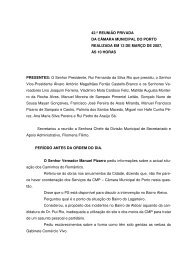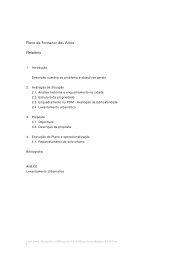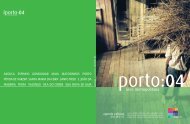2. Mater. Colect. [42-59] - Câmara Municipal do Porto
2. Mater. Colect. [42-59] - Câmara Municipal do Porto
2. Mater. Colect. [42-59] - Câmara Municipal do Porto
Create successful ePaper yourself
Turn your PDF publications into a flip-book with our unique Google optimized e-Paper software.
Cultural facilitiesMSUQL. COLLECTIVE MATERIAL CONDITIONS.SELECTED INDICATORS• Public libraries per 1,000 inhabitants• Art galleries per 1,000 inhabitants• Museums per 1,000 inhabitantsINTERPRETATION OF THE SUBJECTThe large A existência supply de of espaços cultural verdes facilities é um in a factor city contributes de enorme relevância to the diversitypara of a leisure Qualidade and recreational de Vida de uma activities cidade of e the <strong>do</strong>s population, seus habitantes. and Estes oftenmeans espaços the supply contribuem of educational de forma services decisiva outside para the um formal desenvolvimento educationalsystem. sustentável, na medida em que melhoram significativamente aTo qualidade facilitate <strong>do</strong> access ar e favorecem to books and a permeabilização to culture, to spread <strong>do</strong> solo knowledge, urbano e, por toadvertise outro the la<strong>do</strong>, various constituem forms of espaços artistic creation fundamentais and expression de usufruto and da topromote população, events uma are some vez que of são the locais, functions por played excelência, by these de actividades facilities, for dethe use recreio of the e lazer. resident population but also of the people that come tothe city, namely tourists.The indicator was calculated byconsidering all municipallibraries and private librariesopen to the public. Therefore,school libraries were notconsidered.The role played by libraries is changing. The traditional role of librariesis to lend books, to be read in the library or taken home. However, nowadays libraries supply a number of vastresources, namely access to digital information.In 2000, <strong>Porto</strong> had 111 public libraries, a value that corresponds to a provision of 0.<strong>42</strong> per 1,000inhabitants, higher than the provision of the <strong>Porto</strong> Metropolitan Area and of Portugal.In evolutionary terms, if we compare the last data available with the situation in 1995, there is an increaseof this type of facility in the city, a tendency that is also encountered in the <strong>Porto</strong> Metropolitan Area and inPortugal.Art galleries, besides mirroring the artistic production and the cultural vitality of a territory, are also anopportunity for the population in terms of access to culture, and theirs is a more specific type of audience,which is more interested in different artistic performances (painting, photography, cartoons, sculpture). Giventhese characteristics, art galleries as cultural facilities reach a smaller audience than probably museums orlibraries. However, and considering the diversity and the rotation of the works exhibited, the activity of galleriesalso leaves a mark on the cultural dynamism of the city and on its quality of life.In the space of a decade, the number of art galleries has trebled in the city, a fact that shows the greatdynamism in this level of cultural supply. In 2001, there were 39 galleries in <strong>Porto</strong>, which corresponds to a ratioof 0.15 per 1,000 inhabitants.Urban Audit I comparative data:Number of Public Libraries – 1996.Average: 47.1Minimum: 1 (Stuttgard, Dresden)Maximum: 368 (Vienna)<strong>Porto</strong>: 102Number of city cases: 45SOURCE: INEPUBLIC LIBRARIES PER 1,000 INHABITANTS0.50.40.30.20.10.0PORTO PMA PORTUGAL34


![2. Mater. Colect. [42-59] - Câmara Municipal do Porto](https://img.yumpu.com/51414906/3/500x640/2-mater-colect-42-59-camara-municipal-do-porto.jpg)
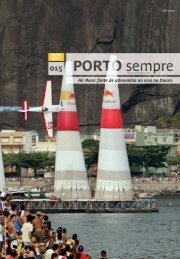


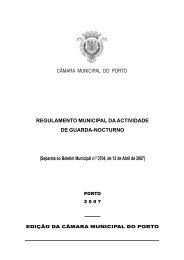

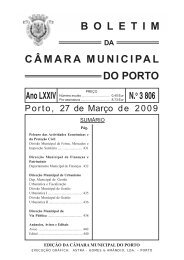

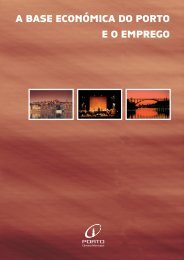

![01.CondAmb [020-031] [INGLæS] - Câmara Municipal do Porto](https://img.yumpu.com/48647213/1/184x260/01condamb-020-031-inglas-camara-municipal-do-porto.jpg?quality=85)
